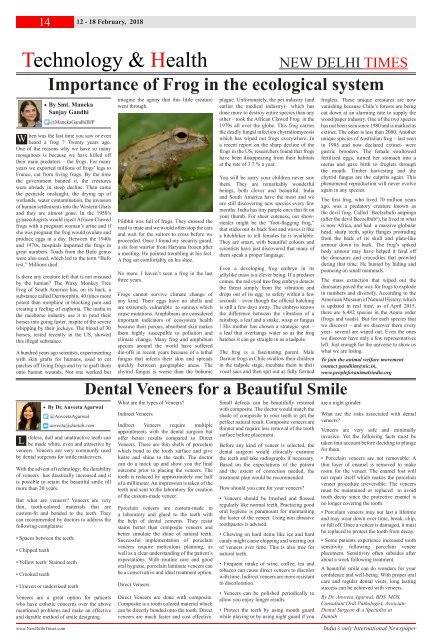12-18 February 2018 - 16-min
You also want an ePaper? Increase the reach of your titles
YUMPU automatically turns print PDFs into web optimized ePapers that Google loves.
14<br />
<strong>12</strong> - <strong>18</strong> <strong>February</strong>, 20<strong>18</strong><br />
W<br />
L<br />
Technology & Health<br />
www.NewDelhiTimes.com<br />
◆◆By Smt. Maneka<br />
Sanjay Gandhi<br />
@ManekaGandhiBJP<br />
◆◆<br />
By Dr. Anveeta Agarwal<br />
@AnveetaAgarwal<br />
anveeta@dantah.com<br />
NEW DELHI TIMES<br />
Importance of Frog in the ecological system<br />
hen was the last time you saw or even<br />
heard a frog ? Twenty years ago.<br />
One of the reasons why we have so many<br />
mosquitoes is because we have killed off<br />
their main predators – the frogs. For many<br />
years we exported millions of frogs’ legs to<br />
France, cut from living frogs. By the time<br />
the government banned it, the creatures<br />
were already in steep decline. Then came<br />
the pesticide onslaught, the drying up of<br />
wetlands, water conta<strong>min</strong>ation, the invasion<br />
of human settlements into the Western Ghats<br />
and they are almost gone. In the 1950’s<br />
gynaecologists would inject African Clawed<br />
frogs with a pregnant woman’s urine and if<br />
she was pregnant the frog would ovulate and<br />
produce eggs in a day. Between the 1940s<br />
and 1970s, hospitals imported the frogs in<br />
great numbers. Toads from the Bufo genus<br />
were also used, which led to the term “Bufo<br />
test.” Millions died.<br />
Is there any creature left that is not misused<br />
by the human? The Waxy Monkey Tree<br />
Frog of South America has, on its back, a<br />
substance called Dermorphin, 40 times more<br />
potent than morphine in blocking pain and<br />
creating a feeling of euphoria. The mafia in<br />
the racehorse industry use it to prod their<br />
horses into going faster, inspite of the severe<br />
whipping by their jockeys. The blood of 30<br />
horses, tested recently in the US, showed<br />
this illegal substance.<br />
A hundred years ago scientists, experimenting<br />
with skin grafts for humans, used to cut<br />
patches off living frogs and try to graft them<br />
onto human wounds. Not one worked but<br />
ifeless, dull and unattractive teeth can<br />
be made white, even and attractive by<br />
veneers. Veneers are very commonly used<br />
by dental surgeons for smile makeovers.<br />
With the advent of technology; the durability<br />
of veneers has drastically increased and it<br />
is possible to retain the beautiful smile till<br />
more than 20 years.<br />
But what are veneers? Veneers are very<br />
thin, tooth-colored materials that are<br />
custom-fit and bonded to the teeth. They<br />
can recommended by doctors to address the<br />
following complaints:<br />
• Spaces between the teeth:<br />
• Chipped teeth<br />
• Yellow teeth/ Stained teeth<br />
• Crooked teeth<br />
• Uneven or undersized teeth<br />
Veneers are a great option for patients<br />
who have esthetic concerns over the above<br />
mentioned problems and make an effective<br />
and durable method of smile designing.<br />
imagine the agony that this little creature<br />
went through.<br />
Pilibhit was full of frogs. They crossed the<br />
road to mate and we would often stop the cars<br />
and wait for the suitors to cross before we<br />
proceeded. Once I found my security guard,<br />
a six foot warrior from Haryana frozen after<br />
a meeting. He pointed trembling at his feet.<br />
A frog sat comfortably on his shoe.<br />
No more. I haven’t seen a frog in the last<br />
three years.<br />
Frogs cannot survive climate change of<br />
any kind. Their eggs have no shells and<br />
are extremely vulnerable to sunrays which<br />
cause mutations. Amphibians are considered<br />
important indicators of ecosystem health<br />
because their porous, absorbent skin makes<br />
them highly susceptible to pollution and<br />
climate change. Many frog and amphibian<br />
species around the world have suffered<br />
die-offs in recent years because of a lethal<br />
fungus that infects their skin and spreads<br />
quickly between geographic areas. The<br />
chytrid fungus is worse than the bubonic<br />
plague. Unfortunately, the pet industry (and<br />
earlier the medical industry)– which has<br />
done more to destroy entire species than any<br />
other – took the African Clawed Frog in the<br />
1970s all over the globe. This frog carries<br />
the deadly fungal infection chytridiomycosis<br />
which has wiped out frogs everywhere. In<br />
a recent report on the sharp decline of the<br />
frogs in the US, researchers found that frogs<br />
have been disappearing from their habitats<br />
at the rate of 3.7 % a year.<br />
You will be sorry your children never saw<br />
them. They are remarkably wonderful<br />
beings, both clever and beautiful. India<br />
and South America have the most and we<br />
are still discovering new species every few<br />
months. India has tiny purple ones that fit on<br />
your thumb. For sheer cuteness, our showstealer<br />
might be the “foot-flagging frog,”<br />
that sticks out its back foot and waves it like<br />
a hitchhiker to tell females he is available.<br />
They are smart, with beautiful colours and<br />
scientists have just discovered that many of<br />
them speak a proper language.<br />
Even a developing frog embryo in its<br />
jellylike mass is a clever being. If a predator<br />
comes, the red eyed tree frog embryo detects<br />
the threat simply from the vibration and<br />
drops out of its egg to safety within a few<br />
seconds – even though the official hatching<br />
is still a few days away. The embryo knows<br />
the difference between the vibration of a<br />
raindrop, a leaf and a snake, wasp or fungus<br />
! His mother has chosen a strategic spot –<br />
a leaf that overhangs water so as the frog<br />
hatches it can go straight in as a tadpole.<br />
The frog is a fascinating parent. Male<br />
Darwin frogs in Chile swallow their children<br />
in the tadpole stage, incubate them in their<br />
vocal sacs and then spit out as fully formed<br />
Dental Veneers for a Beautiful Smile<br />
What are the types of Veneers?<br />
Indirect Veneers<br />
Indirect Veneers require multiple<br />
appointments with the dental surgeon but<br />
offer better results compared to Direct<br />
Veneers. These are thin shells of porcelain<br />
which bond to the tooth surface and give<br />
lustre and shine to the teeth. The doctor<br />
can do a mock up and show you the final<br />
outcome prior to placing the veneers. The<br />
tooth is reduced by approximately one half<br />
of a millimeter. An impression is taken of the<br />
teeth and sent to the laboratory for creation<br />
of the custom-made veneer.<br />
Porcelain veneers are custom-made in<br />
a laboratory and glued to the teeth with<br />
the help of dental cements. They resist<br />
stains better than composite veneers and<br />
better simulate the shine of natural teeth.<br />
Successful implementation of porcelain<br />
veneers require meticulous planning, as<br />
well as a clear understanding of the patient’s<br />
expectations. With routine care and good<br />
oral hygiene, porcelain la<strong>min</strong>ate veneers can<br />
be a conservative and ideal treatment option.<br />
Direct Veneers<br />
Direct Veneers are done with composite.<br />
Composite is a tooth colored material which<br />
can be directly bonded onto the tooth. Direct<br />
veneers are much faster and cost effective.<br />
Small defects can be beautifully restored<br />
with composite. The doctor would match the<br />
shade of composite to your teeth to get the<br />
perfect natural result. Composite veneers are<br />
thinner and require less removal of the tooth<br />
surface before placement.<br />
Before any kind of veneer is selected, the<br />
dental surgeon would clinically exa<strong>min</strong>e<br />
the teeth and take radiographs if necessary.<br />
Based on the expectations of the patient<br />
and the extent of correction needed, the<br />
treatment plan would be recommended.<br />
How should you care for your veneers?<br />
• Veneers should be brushed and flossed<br />
regularly like normal teeth. Practicing good<br />
oral hygiene is paramount for maintaining<br />
the luster of the veneer. Using non abrasive<br />
toothpastes is advised.<br />
• Chewing on hard items like ice and hard<br />
candy might cause chipping and wearing out<br />
of veneers over time. This is also true for<br />
natural teeth.<br />
• Frequent intake of wine, coffee, tea and<br />
tobacco can cause direct veneers to discolor<br />
with time. Indirect veneers are more resistant<br />
to discoloration.<br />
• Veneers can be polished periodically to<br />
allow you enjoy longer results.<br />
• Protect the teeth by using mouth guard<br />
while playing or by using night guard if you<br />
froglets. These unique creatures are now<br />
vanishing because Chile’s forests are being<br />
cut down at an alar<strong>min</strong>g rate to supply the<br />
wood/paper industry. One of the two species<br />
has not been seen since 1980 and is marked as<br />
extinct. The other is less than 2000. Another<br />
unique species of Australian frog – last seen<br />
in 1985 and now declared extinct- were<br />
gastric brooders. The female swallowed<br />
fertilized eggs, turned her stomach into a<br />
uterus and gave birth to froglets through<br />
the mouth. Timber harvesting and the<br />
chytrid fungus are the culprits again. This<br />
phenomenal reproduction will never evolve<br />
again in any species.<br />
The first frog, who lived 70 million years<br />
ago, was a predatory creature known as<br />
the devil frog. Called Beelzebufo ampinga<br />
(after the devil Beezelbub!), he lived in what<br />
is now Africa, and had a massive globular<br />
head, sharp teeth, spiky flanges protruding<br />
from the back of its skull and plate-like<br />
armour down its back. The frog’s spiked<br />
body armour may have helped it fend off<br />
the dinosaurs and crocodiles that prowled<br />
during that time. He hunted by hiding and<br />
pouncing on small mammals.<br />
The mass extinction that wiped out the<br />
dinosaurs paved the way for frogs to explode<br />
in numbers and diversify. According to the<br />
American Museum of Natural History, which<br />
is updated in real time, as of April 2015,<br />
there are 6,482 species in the Anura order<br />
(frogs and toads). But for each species that<br />
we discover – and we discover them every<br />
year– several are wiped out. Even the ones<br />
we discover have only a few representatives<br />
left. Just enough for the universe to show us<br />
what we are losing.<br />
To join the animal welfare movement<br />
contact gandhim@nic.in,<br />
www.peopleforanimalsindia.org<br />
are a night grinder.<br />
What are the risks associated with dental<br />
veneers?<br />
Veneers are very safe and <strong>min</strong>imally<br />
invasive. Yet the following facts must be<br />
taken into account before deciding to plunge<br />
for them.<br />
• Porcelain veneers are not removable: A<br />
thin layer of enamel is removed to make<br />
room for the veneer. The enamel lost will<br />
not repair itself which makes the porcelain<br />
veneer procedure irreversible. The veneers<br />
must be maintained or replaced to avoid<br />
tooth decay since the protective enamel is<br />
no longer covering the tooth.<br />
• Porcelain veneers may not last a lifetime<br />
and may wear down over time, break, chip,<br />
or fall off. Once a veneer is damaged, it must<br />
be replaced to protect the tooth from decay.<br />
• Some patients experience increased tooth<br />
sensitivity following porcelain veneer<br />
placement. Sensitivity often subsides after<br />
about a week following treatment.<br />
A beautiful smile can do wonders for your<br />
confidence and well-being. With proper oral<br />
care and regular dental visits, long lasting<br />
success can be achieved with veneers.<br />
By Dr. Anveeta Agarwal, BDS, MDS,<br />
Consultant Oral Pathologist, Associate<br />
Dental Surgeon & a Specialist at<br />
Dantah<br />
India’s only International Newspaper
















